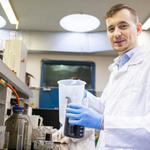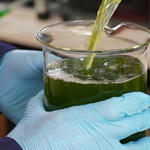https://img.scoop.it/B4ldScF6XnfJGwnRBJQsrYwfd4rmSzZ9adCad5ouJJE=

|
|
| |
| |
|
The 411 for Water Treatment Professionals
|
|
|
|
|
| |
| |
| |
|
MENDELU Researchers Investigate Potential Uses of Coffee Grounds in Wastewater Treatment
|

Wastewater treatment is a biological process carried out using many different chemicals. According to scientists from Mendel University (MENDELU), some of these could be replaced by substances of natural origin. The experts are investigating the additives used in sewage treatment plants to separate sludge. They are trying to replace so-called flocculants with compounds contained in coffee grounds and waste from wine production. Scientists are trying to eliminate certain chemicals, because the sludge is commonly used on agricultural land. About 800,000 tons of untreated sewage sludge are produced in the Czech Republic annually.
|
|
| |
|
Poo-Eating Algae Speeds up Wastewater Treatment in Lockyer Valley Trial
|

Supercharged poo-eating algae are being used to speed up waste treatment times in an Australian-first trial in south-east Queensland. Urban Utilities, which is owned by councils across the state's south-east, is trialling the new technology in the Lockyer Valley town of Helidon, west of Brisbane. The $5-million trial is in partnership with researchers at the University of Queensland, including Dr Andrew Ward from the Australian Centre for Water and Environmental Biotechnology.
|
|
| |
|
North America’s Largest Floating Solar Array Supports New Jersey American Water Treatment Plant
|

From air conditioning to vacuum cleaners, New Jersey has long been known for its innovations, and now it is home to the largest floating solar array in North America. Consisting of 16,510 solar panels, the 8.9-megawatt (MW) solar array covers 17 acres of the Canoe Brook reservoir in Short Hills, New Jersey. The clean power generated is enough to power 1,400 homes annually and will provide approximately 95% of the power needs for New Jersey American Water’s Canoe Brook Water Treatment Plant.
|
|
| |
|
|
| |
| |
| |
|
Towards Energy Positive Wastewater Treatment
|
Wastewater treatment is an essential process to ensure the health and safety of communities and the environment. However, conventional wastewater treatment plants consume significant amounts of energy, contributing to greenhouse gas emissions and high operational costs. As the global population continues to grow and the demand for clean water increases, there is a pressing need to explore innovative and sustainable solutions for wastewater treatment. One such solution is energy positive wastewater treatment, which aims to generate more energy than it consumes, ultimately reducing the environmental impact and operational costs of these facilities.
|
|
| |
|
|
| |
| |
| |
|
Case Study: Beauty & Personal Care Facility Reduces Wastewater Discharge Costs & Carbon Footprint
|
Before investing in new technology solutions, industrial users should conduct a holistic review of their water systems to identify opportunities to elevate existing infrastructure capabilities or adjust operational approaches. Together, trusted technology partners and in-house engineers and technicians who have intimate knowledge of facility needs will be able to determine the best way to facilitate water circularity, but also operational intensity, keeping costs in mind. Treating beauty and personal care wastewater is challenging due to its nature and the high quantity of organics in its waste streams which are not readily biodegradable.
|
|
| |
|
|
| |
| |
| |
|
Wastewater Treatment Plants, an “Escape Gate” for Escape Pathogens
|
Antibiotics are an essential tool of modern medicine, contributing to significantly decreasing mortality and morbidity rates from infectious diseases. However, persistent misuse of these drugs has accelerated the evolution of antibiotic resistance, negatively impacting clinical practice. The environment contributes to both the evolution and transmission of resistance. From all anthropically polluted aquatic environments, wastewater treatment plants (WWTPs) are probably the main reservoirs of resistant pathogens.
|
|
| |
|
Hydrogen and Dark Oxygen Drive Microbial Productivity in Diverse Groundwater Ecosystems
|
Around 50% of humankind relies on groundwater as a source of drinking water. Here we investigate the age, geochemistry, and microbiology of 138 groundwater samples from 95 monitoring wells (<250 m depth) located in 14 aquifers in Canada. The geochemistry and microbiology show consistent trends suggesting large-scale aerobic and anaerobic hydrogen, methane, nitrogen, and sulfur cycling carried out by diverse microbial communities.
|
|
| |
|
Onsite Biological Treatment Will Enhance River Quality
|
Technology from WCS Environmental Engineering has been selected by United Utilities to deliver biological treatment at a new wastewater treatment works. The UK utility is investing £8.2 million in the new facility in the village of Chipping in the Ribble Valley, Lancashire, a capital project designed to manage the area’s recent and future population growth. Due to complete in summer 2024, the new works will also improve water quality in Chipping Brook, a tributary of the River Ribble, which flows through the Yorkshire Dales National Park.
|
|
| |
|
|
| |
|
|